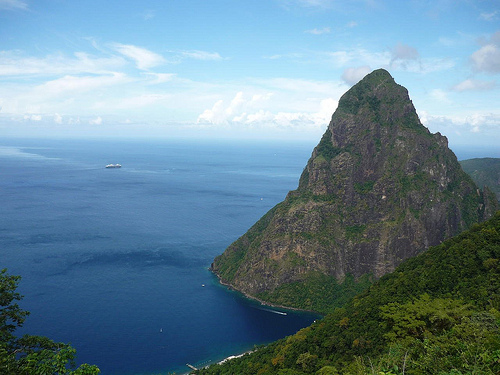‘The Land, The People, The Light’ – the motto of Saint Lucia.
- Saint Lucia is an island located in the West Indies, in the Caribbean Sea, close to the Atlantic Sea, and is one of the Windward Islands of the Lesser Antilles volcanic island arc.
- Saint Lucia covers an area of 617 square kilometres (238.2 square miles) and its highest peak, Mount Gimie, is 950 metres (3,120 feet) high.
- It is believed that Saint Lucia was first discovered by Europeans around the early 1500s, most likely by the Spanish navigator, Juan de la Cosa.
- Saint Lucia was first settled unofficially in the 1550s by a French pirate named François le Clerc, and it wasn’t until the mid 1600s that French Jacques Dyel du Parques is said to have successfully built a settlement and appointed a governor there, although previous failed attempts had occurred by both the French and British.
- Saint Lucia has a significant musical culture, particularly in folk music, and it hosts an annual jazz festival.
Part of Saint Lucia
Image courtesy of Charles Kenny/Flickr
- Saint Lucia officially became a part of the Commonwealth in 1979, and therefore has the British monarch as its head of state, and it is ruled by a prime minister and a democratic government.
- Saint Lucia’s population in 2010 was 174,000 and its capital is Castries.
- Saint Lucia is divided into eleven districts, or quarters, created by the French, and despite being settled by the French, it was fought over by the British for 150 years and changed hands between France and Britain numerous times.
- The majority of Saint Lucian residents speak Creole French, a French dialect which is also known as ‘Patois’, though the official language is English.
- Saint Lucia has a UNESCO World Heritage Site that includes two volcanic spires called the ‘Pitons’ and Sulphur Springs that are active hot springs, and its main industries are bananas and tourism, as the island sees a large quantity of tourists each year.
Bibliography:
History of Saint Lucia, 2011, Geographia, http://www.geographia.com/st-lucia/lchis01.htm
Saint Lucia, 2014, Wikipedia, http://en.wikipedia.org/wiki/Saint_Lucia








